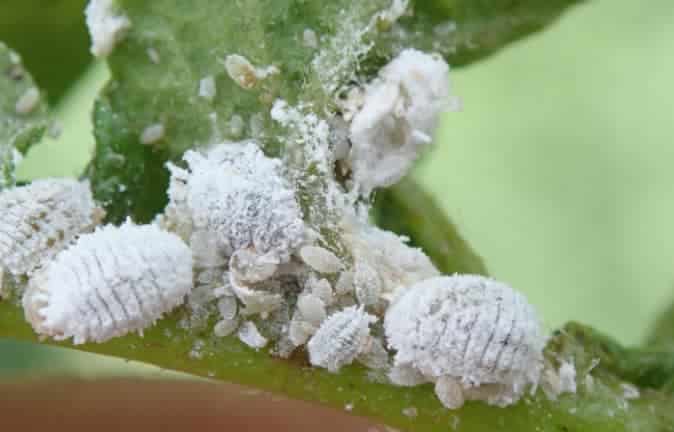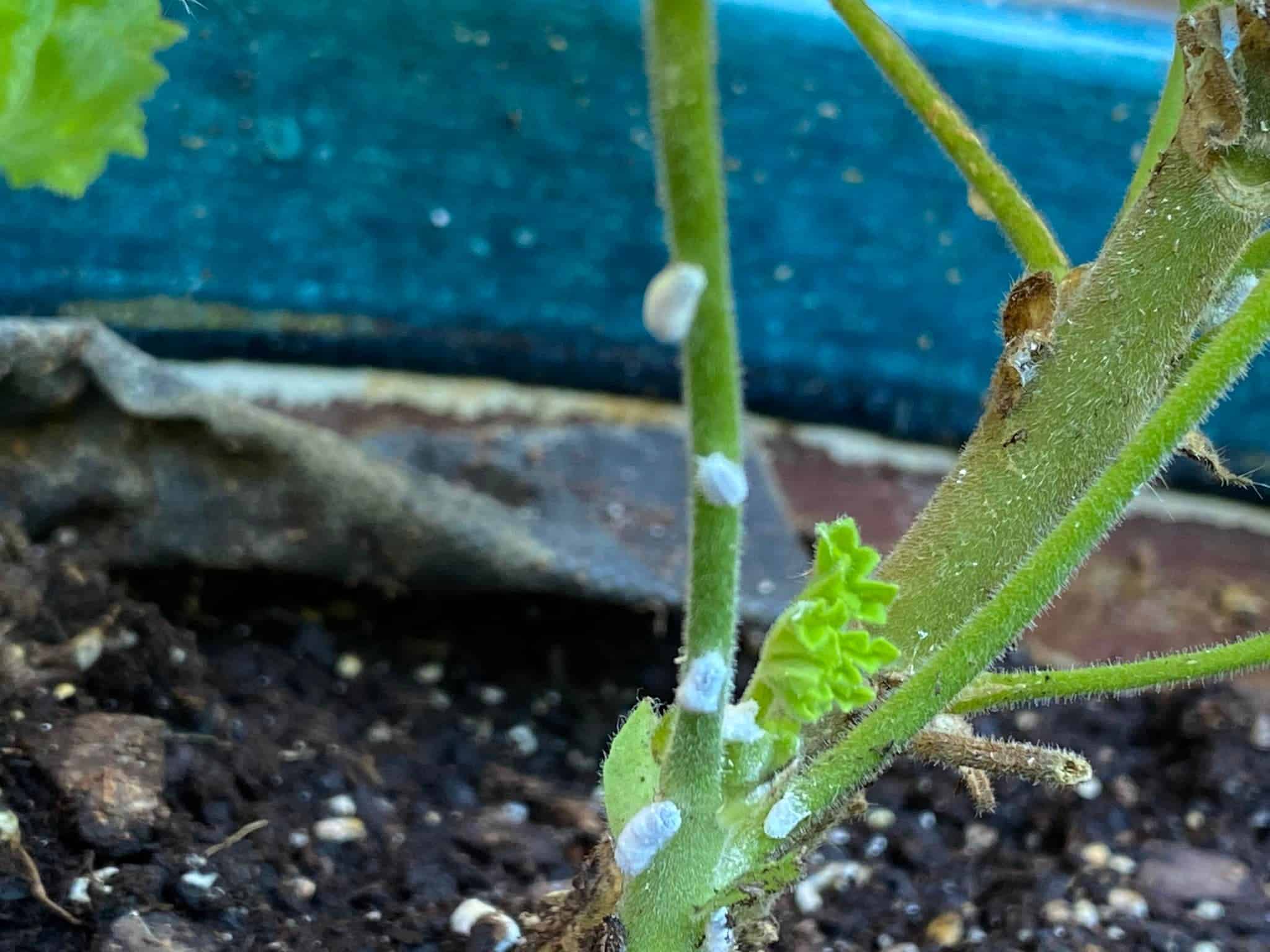Are you struggling with mealybugs wreaking havoc on your beloved plants? I understand your frustration. These tiny, fluffy, cotton-like pests can be a nightmare, draining the life out of your plants by sucking their sap.
Mealybugs’ damage on your plants can turn the leaves yellow, cause stunted growth, and even death. Fortunately, you can save them without having to resort to chemicals.
In this post, we discuss practical and natural ways to help you get rid of mealybugs naturally, ensuring your plants remain healthy and vibrant.
Signs of a Mealybug Infestation
Before taking any action to address the problem, confirm that you really are dealing with mealybugs. The signs below can signify their presence.
a) White, Cotton-Like Masses
This is the hallmark mealybug infestation sign. Mealybugs produce a waxy secretion that covers their bodies, forming a characteristic white, cottony, or powdery appearance. This wax protects mealybugs from dehydration, predators, and environmental conditions.
Since mealybugs often gather in large numbers, this amplifies their cotton-like appearance. This clustering can create dense, noticeable masses on plants. Inspect the undersides of leaves, stems, and leaf axils, as these insects often hide in these places.
b) Black Sooty Mold
Mealybugs excrete a sticky, sugary substance known as honeydew that sticks on the plant’s leaves and stems. Honeydew encourages the growth of sooty mold (a black, powdery fungus) on the surfaces of plants.
In addition, honeydew attracts ants, so an increase in ant activity on and around your plants can signify a mealybug infestation.
Read More:
- How To Get Rid Of Whiteflies
- How To Get Rid Of Japanese Beetles
- How To Get Rid Of Ants In Garden Without Killing Plants
- How To Get Rid Of Slugs And Snails In Garden Naturally
c) Yellowing and Dropping Leaves
Mealybugs can cause the leaves to turn yellow, often beginning at the leaf margins and progressing inward. Also, the leaves may fall off prematurely or appear generally weak and unhealthy.
d) Stunted Growth
Severe mealybug infestations can stunt the growth of plants, leading to weak, undersized, or deformed new growth. Plants may also stop growing or grow very slowly.
10 Ways To Get Rid Of Mealybugs Naturally
With your suspicions confirmed, act quickly before the issue escalates. Below are effective natural ways to get rid of mealybugs on your plants .
1. Pick The Mealybugs Off The Affected Plants
Picking these mealybugs off your plants by hand is understandably yucky, but this approach is direct and provides immediate results. Handpicking mealybugs is effective, particularly when dealing with a few infested parts.
Separate the affected plants from the rest. After that, put on gloves, pick the mealybugs from your plants, and then squish them or drown them in a bucket with soapy water.
Use tweezers or a small brush to remove mealybugs from hard-to-reach areas or delicate plants for more precision. Be careful when plucking these insects to avoid damaging the plant tissue. Rinse your plants afterward.
2. Kill Mealybugs With Alcohol
If you cannot stomach removing mealybugs by hand, dip a cotton swab or cotton ball in 70% isopropyl alcohol or rubbing alcohol and gently dab the affected parts with the alcohol-soaked cotton. The alcohol dissolves the mealybugs’ protective coating and kills them.
Remove dead mealybugs from your plant’s surfaces with a cloth or tissue, then dispose of them. Rinse your plants with water after removing the mealybugs to remove any remaining insects and their honeydew.
You can also spray the affected plants with an alcohol solution (mix water and alcohol) for broad application. Thoroughly cover the affected parts, but don’t over-saturate the plant to avoid alcohol burn.
3. Use Soapy Water
Mix water and mild dish soap and thoroughly coat the affected plant parts, including the leaves’ undersides, with the solution. Alternatively, dip a cotton swab or soft cloth in the soapy water and wipe the mealybugs off the plant.
Soapy water works particularly on young mealybugs who haven’t developed the protective layer yet.
4. Blast Them With Water
A strong stream of water can also help you remove mealybugs from your plants. Consider this approach, especially for outdoor plants and sturdy indoor plants. Set your garden hose or sink sprayer to a gentle yet strong stream.
Support the plant to avoid breaking branches or leaves, and then aim the stream directly at the mealybug-infested areas. After blasting the mealybugs with water, inspect the plant to see if any pests remain. Repeat the process if necessary.
5. Douse The Plants With Neem Oil
Spraying neem oil on mealybugs can lead to their demise. This natural substance disrupts their reproductive and feeding cycles. Mix water (a quart), neem oil (1 to 2 teaspoons), and mild liquid soap (a teaspoon), and adequately coat your plants.
6. Apply Insecticidal Soap
Quickly kill mealybugs with this non-toxic, eco-friendly solution. Insecticidal soap disrupts the insects’ cell membranes, leading to dehydration and death. Buy a pre-made insecticidal soap or combine and mix 1 tablespoon of liquid dish soap with 1 quart of water.
Spray your plants with the solution. Insecticidal soap must come into direct contact with the mealybugs to be effective. Keep in mind that this method won’t prevent future infestations on its own because insecticidal soap doesn’t have a long-lasting residual effect.
7. Introduce Natural Predators
Several insects feed on mealybugs and can help you keep their population in check. Common predators that effectively eradicate mealybugs are ladybugs, predatory mites, lacewings, and parasitic wasps. Even birds like wren, titmice, and chickadee eat mealybugs.
You can buy and introduce mealybugs’ natural predators to your garden. After purchasing, do this:
- Ladybugs: Place them directly on or near the infested plants in the evening or morning.
- Lacewings: Place the eggs or larvae on infested plants where they will hatch and start feeding on mealybugs. Release them in multiple spots around your garden for widespread coverage.
- Parasitic Wasps: Release them directly on infested plants where they will lay their eggs inside mealybugs, eventually killing the host.
- Predatory Beetles: Place predatory beetles directly on the infested plants.
Buying isn’t the only way to introduce natural predators into your garden. Encourage them to your garden by refraining from applying chemical pesticides.
Also, grow flowering plants to provide nectar and pollen, which beneficial insects need for survival.
- Ladybugs: plant yarrow, marigolds, and daisies
- Lacewings: plant coriander, dill, and fennel
- Parasitic wasps: plant yarrow, caraway, and alyssum
As for birds, attract them by providing bird feeders, baths, and houses.
8. Homemade Garlic, Onion, and Chili Spray
This natural insecticide made from readily available kitchen ingredients effectively controls mealybug infestation. This recipe combines garlic, onion, and chili peppers’ strong odors and insect-repelling properties to create a potent mealybug deterrent.
Blitz a bulb of onion and garlic and a teaspoon of cayenne pepper in a blender to create a paste. Add water and continue blending until it is smooth. Steep the mixture for an hour or more, strain it, and then add a tablespoon of liquid soap to the solution.
Apply the spray on the affected plants. You can store any remaining solution in the refrigerator, but use it within a week.
9. Diatomaceous Earth (DE)
Dust a fine layer of food-grade DE on the leaves and around the base of the plants to dehydrate and kill mealybugs. Reapply it after watering or rain.
10. Prune Infested Plants
Is the mealybug infestation localized to only a couple of branches and leaves? You can fix this problem by pruning and discarding the affected parts. Carefully examine your plants to locate the heavily infested areas.
Pruning provides an immediate reduction in the mealybug population. In addition, removing damaged and infested parts will make your plants healthier. The downside is that pruning is time-consuming, especially for large plants or severe infestations.
Moreover, excessive pruning can stress the plant.
How To Prevent Mealybugs
a) Monitor Your Plants
You can prevent a full-blown mealybug infestation through early detection. Regularly inspect your plants for these insects’ signs and presence and isolate any infected plants immediately if you spot any mealybug.
b) Keep Your Plants Healthy
Healthy plants are less vulnerable to mealybug attacks, so ensure your plants stay healthy. For instance, avoid overwatering them, as damp conditions can attract mealybugs. Also, space your plants appropriately and prune crowded growth for good air circulation.
Fertilize your plants with a balanced fertilizer and avoid using excess nitrogen because this nutrient causes these insects to reproduce faster.
c) Quarantine New Plants
Before introducing new plants to your outdoor or indoor garden, inspect and isolate them.
d) Clean and Sanitize Gardening Tools
Clean and disinfect gardening tools between uses and any plant containers you reuse to prevent the spread of mealybugs and other pests.
e) Wipe Foliage Regularly
Regularly wiping your plants’ foliage keeps your plants clean and reduces the likelihood of pests taking hold. Dampen a soft cloth or cotton pad with distilled or filtered water or mild, diluted soap solution and gently wipe the leaves.
f) Choose Mealybug-Resistant Plants
While no plant is entirely immune to mealybugs, some are less susceptible or less attractive to them. Consider planting them if these insects are common in your area. These include Jade, Geraniums, Schefflera, Aspidistra, and Sansevieria.
Concluding Remarks
Mealybugs are persistent and can quickly spread from plant to plant, so you must be persistent in controlling and preventing them. Also, you may need to combine multiple natural methods to eliminate them. Also, monitor your plants diligently and act swiftly.

I’m Mike Hyle, an exterminator with 7+ years of experience handling all sorts of pests, including mice, cockroaches, bed bugs, and termites. I also write for Pest Solutions DIY blog to share my knowledge and help homeowners keep their homes pest-free. Outside work, I enjoy hunting, snowshoeing, and exploring nature. Check out my blog for helpful pest control tips!



